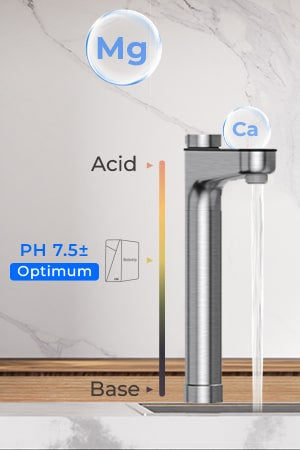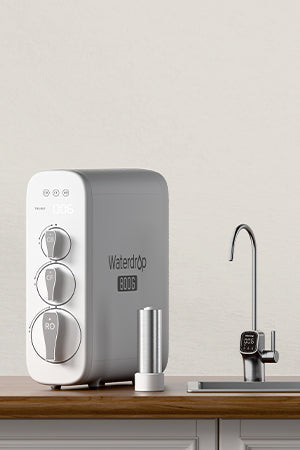Reverse osmosis is an advanced
Water filtration technology that
is enjoying increasing popularity in today's market. It has a precise filter capacity of 0.0001 microns,
which means that it can effectively remove almost all contaminants in your drinking water. It delivers
pure filtered water that consists only of water molecules and no impurities.
If you are looking for an effective solution for cleaning your water
you should definitely consider a reverse osmosis water filter, especially in regions with
poor water quality.
The operating process of the reverse osmosis water filter system
Now that you have decided on a reverse osmosis water filter system to
To provide your household with clean, filtered water, the next step is to understand
how it works. These filter systems are equipped with advanced reverse osmosis membranes that
always provide excellent filtration performance.
RO filters are based on the reverse osmosis process to ensure effective filtration
As the name suggests, reverse osmosis is the opposite of the traditional osmosis process.
While osmosis occurs naturally through the movement of a solvent from an area of high
concentration to a low concentration area, while there is a permeable membrane
Reverse osmosis is a forced process in which the solvent molecules are under hydrostatic pressure
pressure from an area of low concentration to an area of high concentration.

When the solvent (contaminated water) passes through the reverse osmosis membrane,
the membrane separates it into water molecules and other molecules. The other molecules are larger than the
0.0001 micron pore size of the RO membrane, making it impossible for them to pass through. These other
Molecules include bacteria and other contaminants in your tap water. But it also contains useful
Substances such as salts and minerals. Therefore, the filtered water from reverse osmosis systems does not contain the
Minerals that were originally contained in tap water.
Important Minerals in Drinking Water
The human body needs important minerals and trace elements to function optimally
to function. The body absorbs these minerals from the water and uses them to fulfil various functions
in different parts of the body. These minerals contribute, for example, to the general immunity of the body
and include;
calcium
Calcium is an important mineral in drinking water, but calcium-containing water
is unsuitable for cleaning and washing. Calcium present in water contributes significantly to the formation and
structural development of teeth and bones. It contributes to the prevention of serious diseases in
human body, such as high blood pressure,
kidney stones and stroke. Calcium also prevents
the
blood clotting and muscle contraction when present in optimal amounts in the body.
magnesium
Magnesium is also an important element for the body. It protects the body
from heart problems and other critical diseases. Magnesium is important for many processes in the body, including
Among other things, for the regulation of muscle and nerve function, blood sugar levels and blood pressure as well as for
the formation of proteins, bones and DNA. However, few Americans consume sufficient
Magnesium through food.
sodium
The importance of sodium as an essential element has two sides. Firstly
The human body needs sodium, but only in the recommended daily dose. Secondly, too much
Sodium in the body leads to a variety of health risks, including high blood pressure.
fluoride
In some areas,
fluoride is naturally present in the water. It is added to the water
but also artificially added to prevent tooth decay in humans. Health
Risks have been linked to excessive fluoride consumption. However, these claims are only true in areas
with extremely high fluoride consumption and have not yet been scientifically proven.
iron
Iron is important in the body, among other things, for the transport of oxygen in the bloodstream
Interestingly, an iron content in the water of more than 0.3 mg/l causes red, yellow or
brown stains in dishes, glassware, laundry and household appliances such as sinks and bathtubs. Iron deficiency
is a widespread nutritional disorder worldwide. It is also the leading cause of anemia in the
pregnancy, childhood and infancy.
copper
Copper is present in small amounts in natural waters. It is a
essential trace element that the body needs to function optimally. An average
Adults need about 2-3 mg of copper daily to stay healthy. It plays an important role in
bone strength, defense mechanisms, infant growth, and much more.
What are the benefits of mineral water?
Although filtered water from reverse osmosis systems does not contain any toxic elements,
but also none of the important minerals mentioned above.
It is essential for optimal body function. The remineralization of your
RO water can restore the essential elements lost during reverse osmosis filtration without
impurities are added. Mineralized water contains important micronutrients, including calcium,
Magnesium and other trace elements. Calcium contributes to stronger teeth and bones, while magnesium is a
Co-factor and activator for over 300 enzymatic reactions in the body. The muscles and nerves in the
Bodies need sodium to function effectively.
Click
here to learn the benefits of mineral water.
It has a better taste. Most water drinkers can tolerate the taste of
Reverse osmosis water differs from other types of water. This is because RO water is unpleasant and
tastes bland. In contrast, alkaline water with the added minerals retains a
better and great taste. It also helps to overcome cravings for soda or juice.
It encourages people to drink more water. Drinking more water helps to
To keep the body hydrated and reduce the frequency of thirst - the electrolytes in mineralized
Water helps to quench thirst better and faster than normal filtered water. The flat and bland
Taste of RO water is due to its neutral pH value, while the better taste of
The advantage of remineralized water is its alkaline pH value. The latter is ideal
for drinking, cooking and preparing tea, coffee and other beverages. The better the taste,
the more likely you are to drink more water, and the more water you drink, the more hydrated you are.
How to remineralize reverse osmosis water?
The lack of the necessary microelements in RO water does not mean that we
should no longer drink. The RO filter process removes harmful contaminants such as bacteria, viruses and
Heavy metals from tap water. If you eat a strictly balanced diet and drink enough water after exercise,
If you drink electrolytes, you will have no problem. However, if you do not get these micronutrients through a balanced
Diet and electrolyte intake can supplement your immune system, you should consider other options for
Consider remineralizing your RO drinking water.
The easiest way to enjoy the benefits of mineralized water is
Without sacrificing effective reverse osmosis filtration, a reverse osmosis system with a
Remineralization filter. In contrast to the normal RO water filters with three filter stages, these
Models have an additional activated carbon filter or a remineralization filter, which gives the water the
Adds minerals again and ensures a balanced pH value.
The Waterdrop G3P800 under-counter reverse osmosis system combines a robust
3-stage filter process with a limescale protection agent to ensure first-class filtered water without limescale deposits
The remineralization filter can add 18 different natural substances back to your drinking water.
Drinking this filtered water largely prevents chronic diseases and improves digestion
and the immune system.
The Waterdrop G3 reverse osmosis system has passed more than 400 chemical laboratory tests
to confirm the absence of harmful chemical substances in its components. It is
certified to NSF 58 for TDS reduction and NSF 372 for lead-free material. The
Remineralization filter uses an innovative technique to add back natural substances.
Adding an additional remineralization water filter
For homeowners with an existing reverse osmosis system, you can
Use a separate remineralization filter, which perfectly rounds off the mineralization. Waterdrop offers a
remineralization filter that works with most reverse osmosis water systems and under-sink water filter systems
is compatible.


































































